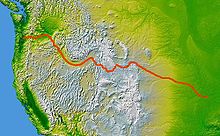Sager orphans
In late autumn 1843, they sold the farm and moved to St. Joseph, Missouri, a jump-off point for the Oregon Trail, where they stayed the winter.
At the end of April 1844, the Independent Colony, 300 people in 72 covered wagons, crossed the Missouri River and started out on the 2,000-mile (3,200 km) journey along the Oregon Trail.
[2] The company was under the command of Captain William T. Shaw, a veteran of the war of 1812, who was traveling with his wife, Sally, and six children.
A couple of days later, while crossing its south fork, Naomi was severely injured as the Sager wagon overturned in the shallow waters along the bank.
A few hours before reaching Fort Laramie, Catherine caught her dress on an axe handle when she jumped out of the moving wagon.
Her left leg, trapped beneath one of the heavy wheels, was broken several times, an event that could have easily been fatal under the medical and sanitary conditions of that situation.
During the descent into the Green River valley some of the travelers fell ill due to an outbreak of camp fever.
Henry took a turn for the worse and was laid up in the wagon next to Catherine, who said that during his last night, "Captain Shaw found him weeping bitterly.
John, the oldest child, carved the words Naomi Carney Sager, age 37 out of a wooden headboard and thus marked the shallow grave.
The train ran out of food besides meat during the journey, and the Shaws split even their last loaf of bread with the Sager children.
In 1836 he and Narcissa, together with a group of other missionaries, joined a caravan of fur traders and traveled west, establishing several missions as well as their own settlement.
Marcus farmed and provided medical care, while Narcissa set up a school for the Native American children.
William Shaw told them that he had promised Naomi that he would try keep her children together in the same family, and made Marcus Whitman sign a contract to keep them together at least until Spring if they were going to adopt the three they wanted.
Francis Sager soon decided to run away and join the settlers in the nearby valley because the Whitmans were strict disciplinarians, and he didn't like living with them.
In the cold and damp weather of November 1847 the epidemic reached its peak and half the tribe died, including most of the children.
While the men who had been working outside were being attacked, Narcissa Whitman took frequent quick looks out the door, and according to Catherine Sager, "At such times she would exclaim: 'Oh, that Jo Lewis is doing it all!'".
She again described almost all of the deaths in the passive voice as having been done with bullets, but says that the Cayuse warriors killed Marcus Whitman with traditional weapons, and that "an Indian" shot one other man.
John McLoughin (who was also a doctor and considered to be the founder of Oregon City), testified on behalf of those five men at their trial, and said he had repeatedly warned Whitman to quit practicing medicine among the Cayuse because they customarily executed their own healers if they did not have the healing powers they claimed to have.
[4] The judge (Orville Pratt) instructed the jury to treat the fact that the Cayuse had turned these five men over for Whitman's death as an admission of guilt, and the jury found them guilty; but the populace of the Oregon Territory considered them sufficiently believable and sympathetic that the recently elected first governor of the territory, Joseph Lane, who had arranged this trial as one of his first acts in office, resigned over the controversy, and his replacement, Kintzing Prichette, vowed to pardon them.
However, Orville Pratt scheduled their execution for before Prichette obtained the ability to act on this vow, and overruled U.S. Marshall Joseph Meek's attempt to delay the hanging given the pending pardon.
Fifty-four women and children were captured and held for ransom, including the daughters of Joseph Meek and Jim Bridger and all the Sager girls.
[8] One month after the massacre, on December 29, 1847, Peter Skene Ogden from the Hudson's Bay Company arranged an exchange of sixty-two blankets, sixty-three cotton shirts, twelve rifles, six hundred loads of ammunition, seven pounds of tobacco, and twelve flints for the return of the forty-nine surviving prisoners.



